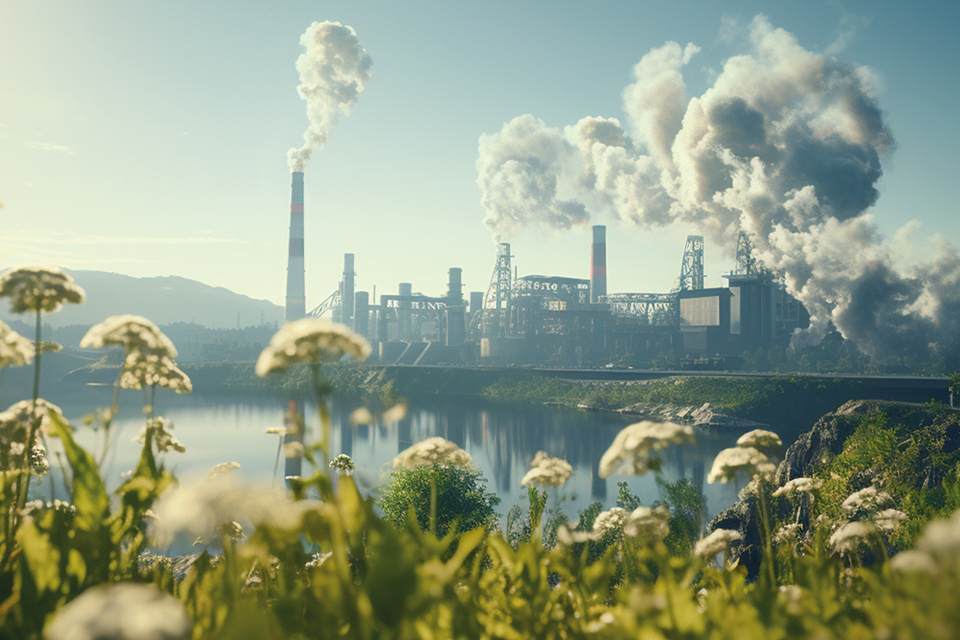2023-11-23
Air Pollution Part 2 – Sources of Gaseous Substances

Air pollutants are effectively either specific gas-phase molecules or small solid-phase particles suspended in the air. The latter are as a collective referred to as particulates. Let’s take a closer look at the origins of gaseous pollutants. Many anthropogenic activities give rise to gaseous air pollutants, but there are also a few natural sources.
Stationary and Mobile Combustion
Gas-phase air pollutants are often generated by combustion processes. In an ideal (stochiometric) combustion reaction, the result of the reaction between the fuel and the oxidant (usually the oxygen in the air) is water vapour and carbon dioxide, CO2. CO2 exists naturally in the air, but the anthropogenic part is considered as an air pollutant and although that share on average is only a fraction of the bulk 400+ ppm, it is still and by far the most abundant air pollutant on earth. The increase of CO2 concentrations is of notable concern since it contributes to the greenhouse effect and ongoing climate changes.
Ideal combustion does not happen in real life. Incomplete combustion can form carbon monoxide, CO. The fuel may contain sulfur and/or chlorine, resulting in formation of gaseous sulfur dioxide (SO2), hydrogen chloride (HCl), and other compounds like dioxins. The high temperature generated by the combustion can cause the nitrogen in the air to form nitrogen oxides (NOX) primarily NO and NO2. Some of the fuel might pass the combustion chamber without being oxidised, resulting in hydrocarbon (“HC”) emissions. Often, its subset volatile organic compounds (VOCs) are of primary concern when it comes to air pollution.
The reaction paths and the formation of pollutants are essentially the same both for stationary sources and for internal-combustion engines for vehicles, although at different scales.
Industrial Production
Many industries are energy intensive and have their own combustion-based power plants, giving rise to emissions of gaseous substances as discussed in the previous section. However, the production process itself can also generate gaseous air pollutants, either emitted intendedly or through diffuse leaks.
By example, refineries have many production steps involving a variety of hydrocarbons such as benzene and xylenes. Some emissions of such substances can be deliberate, some occur as a result of leakages. Crude oil refineries include the removal of sulfur from the fuel which may give rise to hydrogen sulfide (H2S) and/or SO2 emissions. Chemical production facilities can emit a wide variety of hydrocarbons and other pollutants, such as formaldehyde and toluene. Some types of fertiliser production involve ammonia (NH3) which might be emitted through leaks or intended vents. Copper smelters can process sulfur-rich copper ore giving rise to notable SO2 emissions, while aluminium smelters utilise pools of fluoride compounds which may result in emissions of hydrogen fluoride (HF).
Livestock Farming
Farming might not appear as a major contributor to air pollution, but all animals give rise to emissions of above all methane (CH4) and ammonia, and livestock kept at farms can form major sources of such air pollution.
Ozone and Other Secondary Pollutants
The most notable secondary pollutant is ozone. It is referred to as secondary since there are no major anthropogenic sources of ground-level (tropospheric) ozone. Instead, ozone is formed by complex chemical reactions involving NOX, VOCs, and some other substances in the presence of sunlight. Accordingly, where there are emissions of these so-called ozone precursors, there is also a notable risk of finding elevated ozone concentrations. Heat and increased sunlight during the summer months also mean higher levels of ozone during this period of the year. The ozone precursors are typically generated in urban areas through emissions from road traffic and industrial processes. However, high ozone concentrations do not only occur in urban environments. Ozone can travel long distances with the winds, also making it a major air pollutant in areas where there otherwise are very low levels of air pollution. In fact, ozone can also be consumed by reactions with other air pollutants, so the highest levels of ozone can very well be found in rural areas where no consuming reaction paths are available.
The reaction paths resulting in ozone are complex and some intermediate substances are themselves long-lived enough to be considered as air pollutants on their own. The mix of ozone precursors, ozone, sulfur dioxide, and particulates form photochemical smog.
Natural Sources
One of the more apparent types of natural sources of air pollution is volcanoes and other geothermal activities, often emitting sulfurous compounds such as SO2 and H2S. Deposits of methane under sand or permafrost may leak up through the ground and even form local hotspots of high CH4 concentrations.
